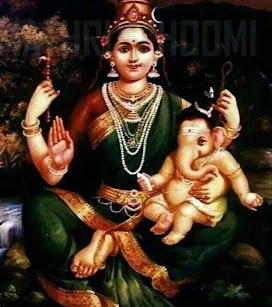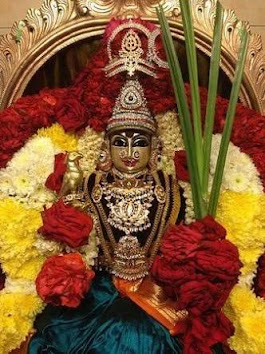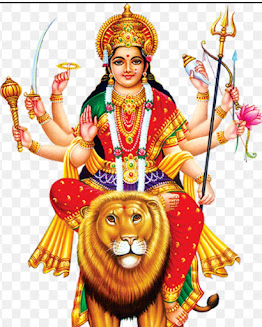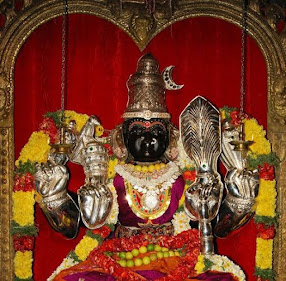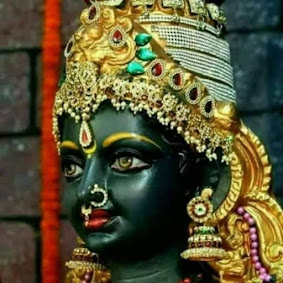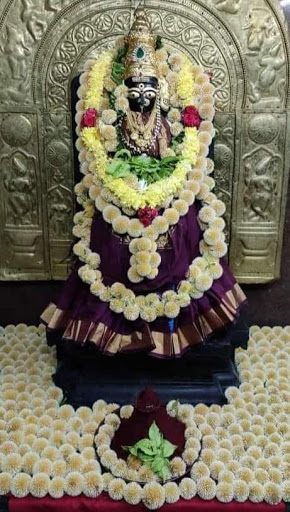Nāma-s 196 to 248 discuss about Her various forms known as saguṇa Brahman or the Brahman with attributes. Worshipping God without form is called nirguṇa worship and considered as superior. Worshipping God in various forms is called saguṇa worship. Religious faiths are based on saguṇa worship (with forms and attributes).
सर्वज्ञा (196)
Sarvajñā
She is omniscient. Only the Brahman alone can be omniscient.
सान्द्रकरुणा (197)
Sāndrakaruṇā
She is compassionate.
समानाधिक-वर्जिता (198)
Samānādhika-varjitā
She has no equals. Śvetāśvatara Upaniṣad (VI. 8) says, “He has no body and no organs. No one is His equal. No one is His superior either. He possesses many powers of knowledge and powers of action.” The Upaniṣad talks about the nature of the Brahman.
Arjuna addresses Kṛṣṇa like this in Bhagavad Gīta ( XI.43) “You are the Lord of incomparable might, in all the three worlds there is none else even equal to You; how then, any better?” She has all these qualities.
सर्वशक्ति-मयी (199)
Sarvaśakti-mayī
She is the power of all śaktī-s. Since She is the embodiment of all śaktī-s, She is known as Śaktī. This is the reason for addressing Her as Sarvaśakti-mayī.
सर्व-मङ्गला (200)
Sarva-maṅgalā
She is the embodiment of all auspiciousness.
सद्गति-प्रदा (201)
Sadgati-pradā
She guides Her devotees in the right path to reach the right target (salvation). The target is realizing the Brahman.
सर्वेश्वरी (202)
Sarveśvarī
She is the supreme ruler of the universe and leads the beings to the Brahman.
सर्व-मयी (203)
Sarva-mayī
She exists in all forms, the omnipresent nature of the Brahman.
सर्व-मन्त्र-स्वरूपिणी (204)
Sarva-mantra-svarūpiṇī
She is the embodiment of all mantra-s. This is one of the reasons why tantra śāstra is based on Her various forms, as mantra-s have vital role in tantric rituals. It is said that all the mantra-s are placed around the Pañcadaśī mantra, which is the centre of all mantra-s.
सर्व-यन्त्रात्मिका (205)
Sarva-yantrātmikā
She is in all the yantra-s. A properly consecrated yantra becomes powerful and its power increases along with the increase in the counts of mantra-s. Since She is sarva-mayī, She is said to be in all yantra-s.
सर्व-तन्त्र- रूपा (206)
Sarva-tantra-rūpā
She is in the form of all tantra-s. There are various types of tantra-s and She is the focal point in all these tantra-s.
मनोन्मनी (207)
Manonmanī
She is in the form of manonmanī (beyond perception). There are eight smaller cakra-s between ājñā cakra and sahasrāra and the one, just below the sahasrāra is called manonmanī. In Śrī Rudram, one of the forms of Śiva is called Manonmana and His wife is Manonmanī. There is a mudrā called manonmanī, which is used in advanced stages of meditation. When this mudrā is used, one almost loses his consciousness, ready to merge with the Supreme.
माहेश्वरी (208)
Māheśvarī
Māheśvara form of Śiva is the Supreme form. His wife is Māheśvarī.
महादेवी (209)
Mahādevī
Śiva is also known as Mahādeva, His moon form and his wife is Mahādevi. Maha also means the Supreme. She is the Supreme and hence called Mahādevi.
महालक्ष्मी (210)
Mahālakṣmī
Śiva manifests in the form of Viṣṇu for sustenance and His wife is Mahālakṣmī. Mahālakṣmī also means a girl of
thirteen years. If Mahālakṣmī is worshipped on every 13th lunar day (trayodaśa) with Her bīja (śrīṃ- श्रीं), there will no dearth of prosperity and auspiciousness.
मृडप्रिया (211)
Mṛḍapriyā
Śiva is also known as Mṛḍan, His sattvic form. Shakthi is called Mṛḍapriyā. Mṛḍa means happiness, a quality of sattva guṇa, showing compassion or mercy, gracious and priyā means dear.
महारूपा (212)
Mahā-rūpā
She has a great form. It is to be observed that all these nāma-s begin with Mahā indicating Her Supreme stature.
महापूज्या (213)
Mahāpūjyā
She is worshipped by great saints and sages.
महापातक-नाशिनी (214)
Mahāpātaka-naśinī
She destroys great sins.
महा-माया (215)
Mahā-māyā
Māyā means illusion. She is known as mahā-māyā svarūpinī.
The entire universe functions on the basis of māyā or illusion. If She does not cast Her effect of māyā on this world, there will no activity at all. Her spell of māyā makes us to seek the Brahman.
महा-सत्त्वा (216)
Mahā-sattvā
Sattvā is one of the three guṇa-s, the other two being rajas and tamas. Out of the three, sattva guṇa is supreme. When this guṇa is dominant in a person, he cannot commit any sins either knowingly or unknowingly. She chooses these persons to shower on them Her special grace.
महा-शक्तिः (217)
Mahā-śaktiḥ
Śaktī means energy. Because of Her sattvic guṇa, She possesses supreme energy, with which She controls the universe.
महा-रतिः (218)
Mahā-ratiḥ
She gives immense happiness and delight to Her devotees. (rati means pleasure, enjoyment, delight in, fondness for). She is the incarnation of auspiciousness.
महा-भोगा (219)
Mahā-bhogā
महा-बुद्धिः (223)
महा-तन्त्रा (226)
महा-याग-क्रमाराध्या (230)
महेश्वर-महाकल्प-महाताण्डव-सक्षिणी (232)
महा-कामेश-महिषी (233)
Mahā-kāmeśa-mahiṣī
The consort of Mahā Kāmeśvara is known as Mahā Kāmeśvarī. Mahiṣī means queen, the queen of Śiva.
महा-त्रिपुर-सुन्दरी (234)
Mahā-tripura-sundarī
She is described as the most beautiful woman of the three worlds. The three worlds are vyāhṛti-s (bhūr, bhuvaḥ, svar) of Gāyatri mantra.
चतुः-षष्ट्युपचाराढ्या (235)
Chatuḥ-ṣaṣṭyupacārāḍhyā
She is worshipped with sixty four (chatuḥ-ṣaṣṭi) types of metaphorical expressions, which are called upacāra-s. For example offering Her scents, flowers, bangles, fanning Her, etc. Sixty four such offerings have been prescribed for Her. This nāma talks about the pūja ritual.
चतुःषष्टि-कलामयी (236)
Catuḥṣaṣṭi-kalāmayī
She is in the form of sixty four types of arts. Kalā means art. There are sixty four types of arts in tantra śāstra-s. No concrete evidence is available to confirm or dispute these sixty four types. But these arts originate from aṣṭama siddhi (the eight super human powers).
महा-चतुः-षष्टि-कोटि-योगिनी-गण-सेविता (237)
Mahā-catuḥ-ṣaṣti-koṭi-yoginī-gana-sevithā
Mahā-catuḥ-ṣaṣti-koṭi means sixty four crores or 640 million. Yoginī-gana are demigoddesses. She is worshipped by these 640 million demigoddesses also known as yogini-s.
मनु-विद्या (238)
Manu-vidyā
She's the embodiment of Manu-vidya. Vidya means Sri Vidhya, the ritual worship of Sri Chakra. Many Vidya refers to the twelve types of pancadasi mantras introduced by Manu.
चन्द्र-विद्या (239)
Candra-vidyā
After Manu, the worship by Chandra is referred in this nāma. She's the embodiment of Chandra Vidya.
चन्द्र-मण्डल-मध्यगा (240)
Candra-maṇḍala-madhyagā
Candra-maṇḍala refers to the sahasrāra. She is in the middle of the sahasrāra.
In the middle of the crown cakra there is an orifice called bindu. She is in the form of this bindu. In fact, in ritual worship of Śrī Cakra, this bindu is the focal point where She is worshipped. The Candra-maṇḍala itself is Śrī Cakra.
चारु-रूपा (241)
Chāru-rūpā
She is the beauty incarnate. Chāru means pretty.
चारु-हासा (242)
Chāru-hāsā
Her smile is in line with Her appearance. Her smile (hāsa) is compared to the moon. Her smile is the cause of bliss experienced by Her devotees.
चारु-चन्द्र-कलाधरा (243)
Chāru-chandra-kalādharā
She is wearing the crescent moon in Her crown. Chāru means moon light.
चराचर-जगन्नाथा (244)
Cāracara-jagannāthā
She controls both animate and inanimate things of the world. She is the cause for both static and kinetic energies.
चक्र-राज-निकेतना (245)
Cakra-rāja-niketanā
Śrī Cakra is known as Cakra rājam, the supreme of all cakra-s. She resides in this Śrī Cakra along with all Her ministers, warriors, etc.
पार्वती (246)
Pārvatī
She is the daughter of Himavān, the king of mountains and wife of Śiva.
पद्म-नयना (247)
Padma-nayanā
Her eyes are compared to lotus flower.
पद्मराग-सम-प्रभा (248)
Padmarāga-sama-prabhā
She is compared to a special type of ruby called padmarāga which is deep red in colour.
